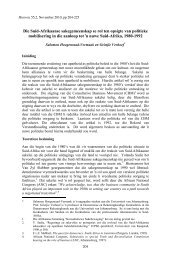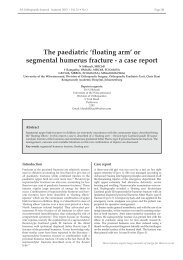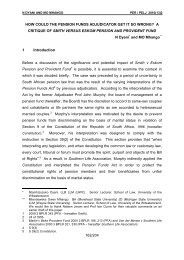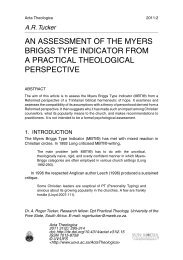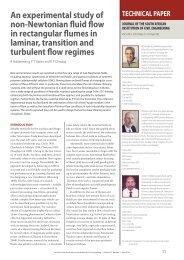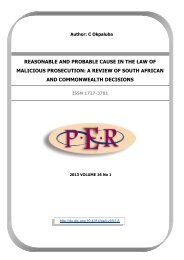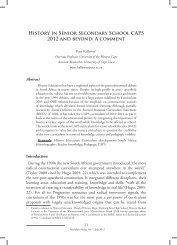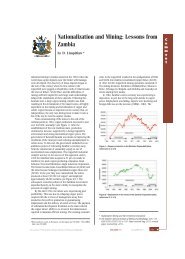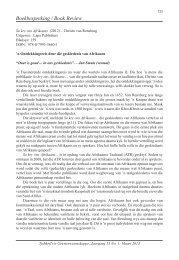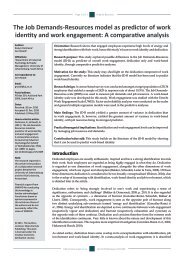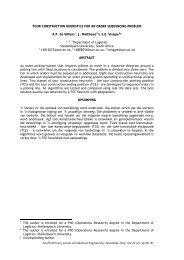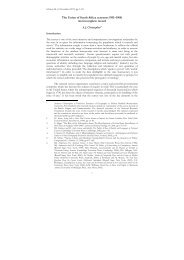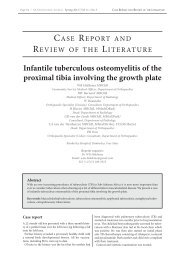A detailed analysis of evolution of water rights in South Africa: An ...
A detailed analysis of evolution of water rights in South Africa: An ...
A detailed analysis of evolution of water rights in South Africa: An ...
Create successful ePaper yourself
Turn your PDF publications into a flip-book with our unique Google optimized e-Paper software.
<strong>water</strong> <strong>rights</strong> <strong>in</strong> general. The next sections deal with the <strong>evolution</strong><br />
<strong>of</strong> <strong>water</strong> <strong>rights</strong> under, respectively, <strong>Africa</strong>n customary law,<br />
Dutch, British, and Afrikaner nationalist laws. F<strong>in</strong>ally, modern<br />
<strong>water</strong> <strong>rights</strong> under the current democratic rule are discussed.<br />
Conclusions and major lessons garnered from this study are<br />
discussed <strong>in</strong> the last section.<br />
A brief overview <strong>of</strong> prevail<strong>in</strong>g <strong>water</strong> <strong>rights</strong><br />
doctr<strong>in</strong>es<br />
The need to regulate and control the supply <strong>of</strong>, and demand for,<br />
<strong>water</strong> by policy measures is necessitated by the need to supply<br />
the resource on susta<strong>in</strong>able basis to all users. One <strong>of</strong> the<br />
important factors <strong>in</strong> allocat<strong>in</strong>g or creat<strong>in</strong>g <strong>water</strong> <strong>rights</strong> is the<br />
climate. Even cultural advancement is considerably <strong>in</strong>fluenced<br />
by climatic conditions. Hall argued that:<br />
‘Climatic and geographical conditions are therefore <strong>of</strong> the<br />
greatest importance when questions <strong>of</strong> <strong>water</strong> <strong>rights</strong> come to<br />
be considered. If there is a scarcity <strong>of</strong> <strong>water</strong> the efforts <strong>of</strong> the<br />
community will be directed towards conserv<strong>in</strong>g the <strong>water</strong> and<br />
those <strong>of</strong> the <strong>in</strong>dividual to obta<strong>in</strong><strong>in</strong>g as much <strong>of</strong> it as he can for<br />
himself. If there is a superfluity <strong>of</strong> it the <strong>in</strong>habitants will be<br />
occupied with efforts to get rid <strong>of</strong> it by dra<strong>in</strong>age and canalisation,<br />
and they will make strenuous efforts to add to their land<br />
by reclaim<strong>in</strong>g new areas from <strong>in</strong>undation (Hall, 1939 p.7)’.<br />
The objective <strong>of</strong> grant<strong>in</strong>g <strong>water</strong> <strong>rights</strong> is thus ultimately<br />
related to improv<strong>in</strong>g the <strong>water</strong> management on the land and<br />
also to us<strong>in</strong>g the scarce <strong>water</strong> resource on a susta<strong>in</strong>able basis.<br />
Supply<strong>in</strong>g <strong>water</strong> on a susta<strong>in</strong>able basis refers to the ability to<br />
provide for all <strong>water</strong> needs, whether they are social, economic,<br />
environmental, physical, biological, or religious, <strong>of</strong> the current<br />
generations without jeopardis<strong>in</strong>g the needs <strong>of</strong> future<br />
generations. The susta<strong>in</strong>able supply <strong>of</strong> <strong>water</strong> to all users is an<br />
immense task complicated by hydrological, logistical, economical,<br />
sociological, organisational, technical and environmental<br />
as well as political issues (DWAF, 1986 p. 1.1).<br />
Apart from climate, the variation <strong>in</strong> <strong>water</strong> uses and hydrological<br />
conditions across the country also <strong>in</strong>fluences the allocation<br />
<strong>of</strong> <strong>water</strong> <strong>rights</strong> <strong>in</strong> a country. For example, the distribution<br />
<strong>of</strong> <strong>South</strong> <strong>Africa</strong>n river systems is concentrated <strong>in</strong> a few<br />
prov<strong>in</strong>ces such as Mpumalanga, Kwazulu-Natal, and the Cape,<br />
while the rest <strong>of</strong> the country is dry. The uneven distribution <strong>of</strong><br />
<strong>water</strong> thus engenders <strong>water</strong> scarcity which <strong>in</strong> turn <strong>in</strong>duces more<br />
str<strong>in</strong>gent rules for <strong>water</strong> use.<br />
It can be said, therefore, that climatic conditions, hydrology<br />
and <strong>water</strong> uses are among the important factors <strong>in</strong> the <strong>evolution</strong><br />
<strong>of</strong> <strong>water</strong> <strong>rights</strong> <strong>in</strong> a country. Among other factors, sociocultural<br />
contexts are important determ<strong>in</strong>ants <strong>of</strong> <strong>water</strong> <strong>rights</strong>.<br />
For example, the environmental and human right to <strong>water</strong> use<br />
has become very important <strong>in</strong> the last half <strong>of</strong> the 20 th century<br />
across the world. There are 4 important legal doctr<strong>in</strong>es that<br />
def<strong>in</strong>e the terms and conditions <strong>of</strong> <strong>water</strong> use, derived from a<br />
comb<strong>in</strong>ation <strong>of</strong> cultural and environmental factors: dom<strong>in</strong>us<br />
flum<strong>in</strong>is, riparian, appropriation, and correlative (Black and<br />
Fisher, 2001 pp. 39-91).<br />
The dom<strong>in</strong>us flum<strong>in</strong>is or absolute ownership pr<strong>in</strong>ciple<br />
requires complete control <strong>of</strong> the resource by the govern<strong>in</strong>g<br />
party. This doctr<strong>in</strong>e prevailed under Dutch rule <strong>in</strong> <strong>South</strong><br />
<strong>Africa</strong>. In the United States it was used by some eastern states<br />
<strong>in</strong> the abstraction <strong>of</strong> ground<strong>water</strong>. Under the riparian doctr<strong>in</strong>e,<br />
the right to the use <strong>of</strong> <strong>water</strong> resides <strong>in</strong> the ownership <strong>of</strong> riparian<br />
lands – property that borders the <strong>water</strong> body. The doctr<strong>in</strong>e<br />
has been modified to make it amenable to local conditions by<br />
various countries. Riparian <strong>rights</strong> cannot be transferred for the<br />
use <strong>of</strong> non-riparian land nor can they be lost by non-use. The<br />
riparian doctr<strong>in</strong>e was derived from the English common law,<br />
which was borrowed <strong>in</strong> part from Roman civil law. In the eastern<br />
United States, the riparian doctr<strong>in</strong>e was commonly used.<br />
British rulers <strong>in</strong> <strong>South</strong> <strong>Africa</strong> also adopted this doctr<strong>in</strong>e.<br />
As per the appropriation or Colorado doctr<strong>in</strong>e, the <strong>rights</strong> to<br />
use <strong>water</strong> are given to those who claim it first; popularly known<br />
as the ‘first <strong>in</strong> time is first <strong>in</strong> right’ pr<strong>in</strong>ciple. The prior appropriation<br />
system is not affected by the ownership <strong>of</strong> the land<br />
and the appropriative <strong>rights</strong> can be lost through abandonment,<br />
unlike riparian <strong>rights</strong>. This doctr<strong>in</strong>e was used <strong>in</strong> the western<br />
United States but was not opted for by <strong>South</strong> <strong>Africa</strong>n rulers.<br />
The correlative <strong>rights</strong> doctr<strong>in</strong>e (also called California<br />
doctr<strong>in</strong>e) comb<strong>in</strong>es certa<strong>in</strong> elements <strong>of</strong> both riparian and<br />
appropriation doctr<strong>in</strong>es and is commonly applied to ground<strong>water</strong>.<br />
This requires that owners <strong>of</strong> the overly<strong>in</strong>g land own the<br />
common aquifer or ground<strong>water</strong> bas<strong>in</strong> as jo<strong>in</strong>t tenants and each<br />
is allowed a reasonable amount for his own use. In the last<br />
quarter <strong>of</strong> the 20 th century, the gradual convergence <strong>of</strong> riparianism<br />
and prior appropriation doctr<strong>in</strong>es has taken place <strong>in</strong><br />
the United States <strong>of</strong> America – thus accept<strong>in</strong>g the importance<br />
<strong>of</strong> <strong>water</strong> regulation (Thompson, 2006 p. 142). For example,<br />
orig<strong>in</strong>ally riparian law was based on the natural flow doctr<strong>in</strong>e<br />
which effectively prohibited diversion <strong>of</strong> <strong>water</strong> from streams.<br />
This worked well <strong>in</strong> the pre-<strong>in</strong>dustrial society. As <strong>in</strong>dustrialisation<br />
proceeded, demand for <strong>water</strong> as a source <strong>of</strong> power for mills<br />
<strong>in</strong>creased, and led to the development <strong>of</strong> the reasonable use<br />
doctr<strong>in</strong>e which allowed for some diversions (Thompson, 2006<br />
p. 144). Under all doctr<strong>in</strong>es, <strong>water</strong> <strong>rights</strong> are, however, usufructuary<br />
which means that a person obta<strong>in</strong>s the right to use but<br />
not own the <strong>water</strong> body (Black and Fisher, 2001 pp. 39-91).<br />
In the <strong>South</strong> <strong>Africa</strong>n context, the first 2 doctr<strong>in</strong>es – dom<strong>in</strong>us<br />
flum<strong>in</strong>is and riparian – were used. For example, the Dutch rulers<br />
s<strong>in</strong>ce 1652 adopted the pr<strong>in</strong>ciple <strong>of</strong> res omnium communes to<br />
impose control over the streams <strong>of</strong> Table Bay Valley, and control<br />
was exercised through a series <strong>of</strong> placcaets. The Company<br />
treated <strong>water</strong> as a public commodity. This was later replaced<br />
by a system where the state was dom<strong>in</strong>us flum<strong>in</strong>is (Uys, 1996<br />
p.190). Under the British rule, <strong>water</strong> was considered a private<br />
commodity and the riparian pr<strong>in</strong>ciple was adopted. Thus, <strong>water</strong><br />
<strong>rights</strong> decisions <strong>in</strong> the court favoured <strong>in</strong>dividuals. However, later<br />
the apartheid regime under Afrikaner rule swung the balance <strong>in</strong><br />
favour <strong>of</strong> the Roman-Dutch law.<br />
The current democratic regime sought to f<strong>in</strong>d a balance<br />
between riparian and dom<strong>in</strong>us flum<strong>in</strong>is pr<strong>in</strong>ciples and <strong>in</strong>troduced<br />
the modern <strong>rights</strong> regime. Water is hence treated as a<br />
semi-public and semi-private commodity and the state adopted<br />
the dual economy model to engender economic development<br />
(Tewari, 2008; Temple, 2005). These themes are followed <strong>in</strong><br />
this study and examples and court cases are supplied to demonstrate<br />
the political and vested <strong>in</strong>terests that existed <strong>in</strong> the development<br />
<strong>of</strong> a certa<strong>in</strong> k<strong>in</strong>d <strong>of</strong> <strong>water</strong> <strong>rights</strong>. It is also for these<br />
reasons that the periodisation <strong>in</strong> <strong>water</strong> <strong>rights</strong> <strong>evolution</strong> tends to<br />
closely follow that <strong>of</strong> the political history <strong>of</strong> the country, as the<br />
2 are <strong>in</strong>alienably l<strong>in</strong>ked.<br />
Water <strong>rights</strong> under <strong>Africa</strong>n customary rule<br />
(pre-colonial era)<br />
Prior to colonisation <strong>of</strong> <strong>South</strong> <strong>Africa</strong>, <strong>Africa</strong>n customary law<br />
governed <strong>water</strong> <strong>rights</strong> <strong>in</strong> the pre-colonial society. The <strong>water</strong><br />
<strong>rights</strong> were then just common knowledge, were not contested<br />
among <strong>in</strong>dividuals <strong>in</strong> the community, and only came up when<br />
a community or a tribe felt that another tribe or community was<br />
694<br />
Available on website http://www.wrc.org.za<br />
ISSN 0378-4738 (Pr<strong>in</strong>t) = Water SA Vol. 35 No. 5 October 2009<br />
ISSN 1816-7950 (On-l<strong>in</strong>e) = Water SA Vol. 35 No. 5 October 2009



